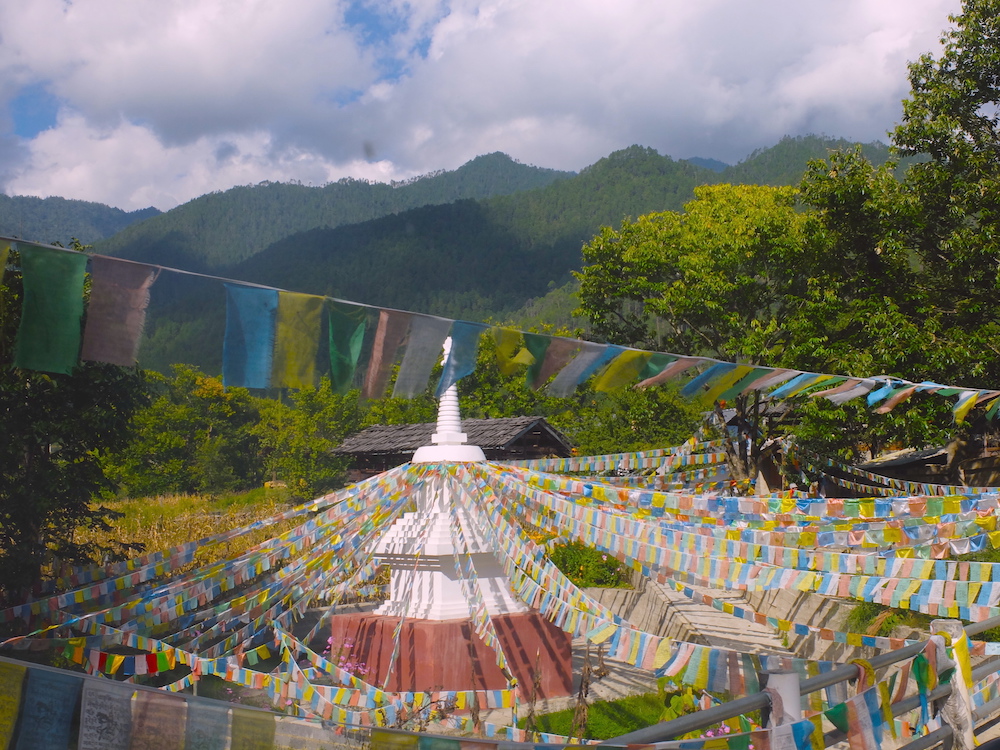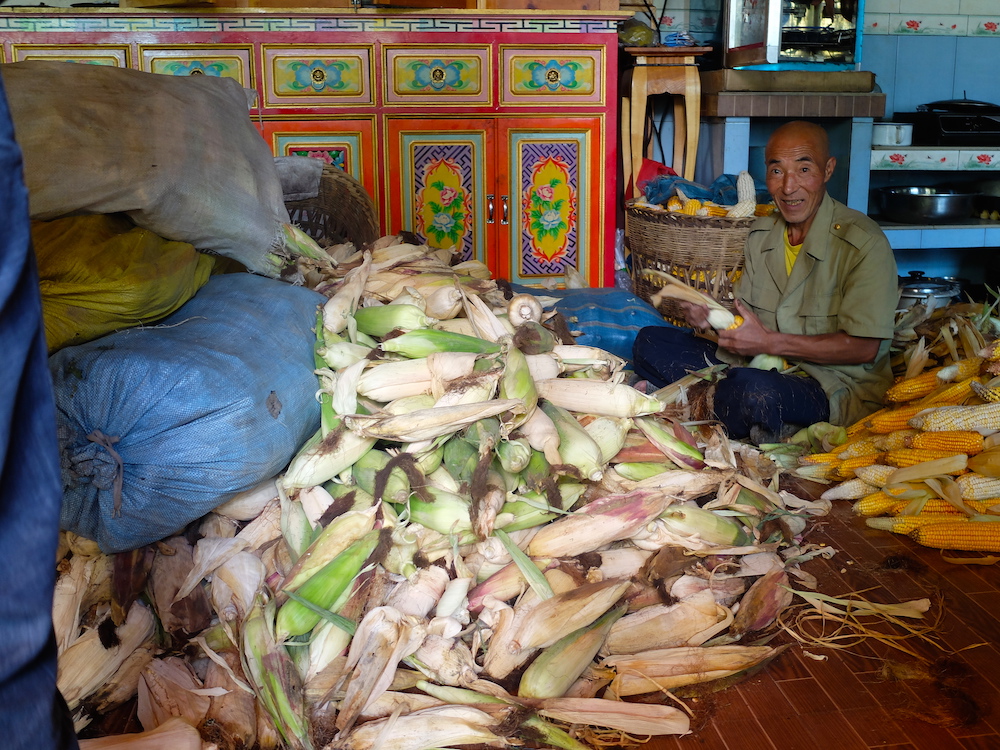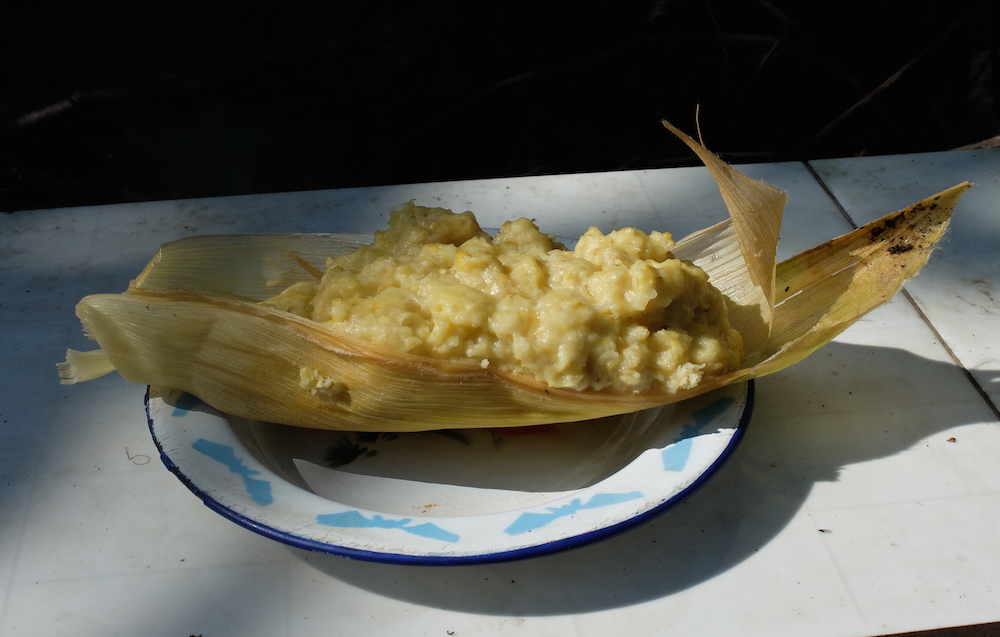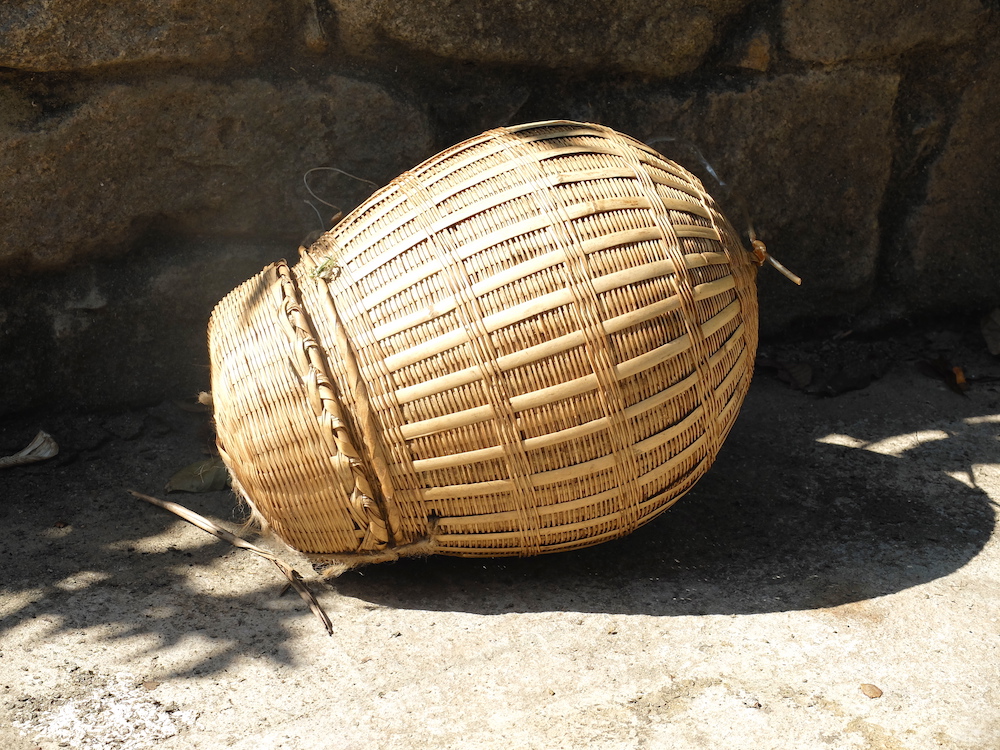Lunch with the Beekeepers
August 20th, 2015

On a bright, sunny morning last year I found myself on an unexpected trip to find a beekeeper. I was traveling in northern Yunnan, near Shangri-la, with my friend Sita and our two little daughters, and my itinerary was full of river gorges, Tibetan monasteries, and crumbling Catholic churches. I had just reached Tacheng, a two-road town situated just west of the Jinsha or “Gold Dust” River (as this northern section of the Yangtze is called), when my guide Tsebo noted that he knew someone in the area I might like to meet. “There’s an American girl who makes honey,” he said. “I can find her number if you want.” In the morning he made a call, and after breakfast we piled into the car to meet Katrina Klett at her home in Kogang Village.

A stupa at the turn to Kogang Village
The area around Tacheng is one of the most beautiful and remote places I have ever visited. We headed out of town, following a small, winding road that runs along a deep stream, then pulled over and asked directions from a couple of farmers who were walking their water buffalo along the side of the road. They told us where to look for the turn-off, and soon we were driving up a well-paved but narrow road into a deep valley. Fields of golden rice and corn filled the valley floor, and everywhere we looked the local villagers were harvesting their crops.
After a few more turns and another phone call for directions, we pulled up to a large farmhouse, and a smiling, blond, distinctly Western woman in her mid-twenties came out to greet us. We had come at just the right time, Katrina told us, as she led us past an old storage house and into a sunny courtyard. She and the family she lived with had just harvested their corn the day before, and after staying up late into the night shucking the harvest, they were planning on spending the day resting and hanging out. We joined her on a couch on a sunny porch, and she brought out butter tea, fresh sunflowers seeds, fruit, little fried cakes of chewy rice flour, and bowls of honey, and told us her story.

Katrina in the garden
Katrina has beekeeping in her blood. Her parents are itinerant beekeepers, and as a child she traveled around the U.S. with them every year, following the demands of pollination seasons. She first came to Yunnan to work for an NGO in Shangri-la and help local beekeepers sell their honey across the province, but she had long since struck out on her own. While working with beekeepers in Kogang Village, she fell in love with another young apiarist, the son of local farmers, and now she lived with them, tending her bees and helping on the farm when she wasn’t traveling around the world as a bee breeding consultant.

Shucking freshly harvested corn
In Kogang, Katrina told us, she had found not only a family but also a vibrant beekeeping tradition. The Lisu minority villagers living in the valley have a rich history of beekeeping, and over the years Katrina had been able to work with them and learn their traditional techniques.
The Lisu excel at finding wild swarms of bees and transplanting their colonies from the mountains into man-made hives in the valley. They usually begin by cutting an opening high in a tree in the forest and waiting until a colony of bees has settled in it, then they return and carefully scoop the bees into a specially-made basket with their hands. “The key is to get the queen, because once the queen is in, the rest will follow her,” Katrina explained. Back in the valley, the bees are transferred to hives and sometimes given a new queen. “The bees from this side of the valley will stay put,” Katrina said, “but if you have bees from that side of the valley you have to re-queen immediately or they’ll fly away.”
During harvest season, no one had time to go looking for new bees, but Katrina invited us to come back sometime and go out into the mountains with her. As I sat in the sun and looked around at the gorgeous valley, I thought I might have to make a trip back there someday to do just that.

Pork belly, cucumbers with chile, and stir-fried fo sho gua

Steamed corn cake
Before we left, Katrina and her Chinese family insisted we share some of their lunch. They quickly brought out a handful of dishes, all of which had been made with food grown on the farm or purchased from neighbors. There was a bowl of simply stir-fried pork belly, cucumbers dressed with a bit of fresh chile, and a delicious dish of stir-fired fo shou gua (佛手瓜), which I recognized as Mexican chayote, seasoned with pork fat, ground chile, and a bit of soy sauce. Before we ate, Katrina also brought out a small cake of freshly ground corn that had been steamed in pieces of corn husk.
“This is a really old local food,” she told us as she dipped some of the corn cake into a bowl of honey. “We made this as a snack while we were shucking the corn last night, and the neighbors came in and laughed at us for eating such peasant food. It’s the kind of thing people used to make when they didn’t have anything else to eat.” Poverty food or not, the corn cake was delicious, as was everything else on the table.

A basket designed for catching wild bees
Photos: Sita Raiter (7)



